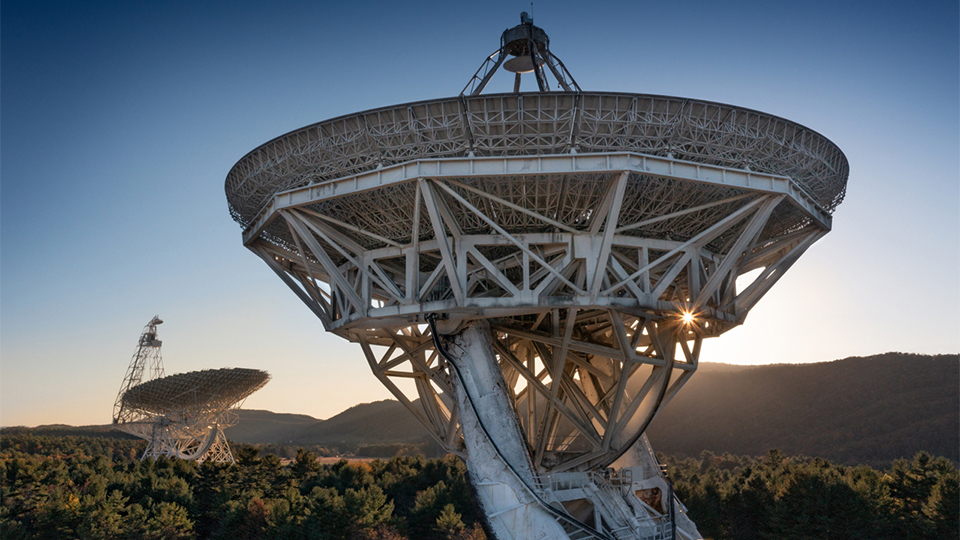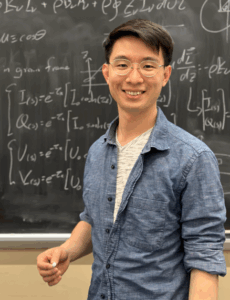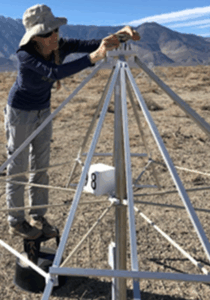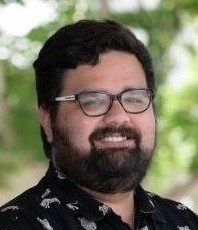The U.S. National Science Foundation National Radio Astronomy Observatory (NSF NRAO), in partnership with several leading Mexican universities and research institutes, has announced a series of landmark agreements and meetings aimed at advancing Mexico’s role in the Next Generation Very Large Array (ngVLA) project.
Recent News
Astronomers Discover a Superheated Star Factory in the Early Universe
Astronomers have uncovered a previously unknown, extreme kind of star factory by taking the temperature of a distant galaxy using the ALMA telescope. The galaxy is glowing intensely in superheated cosmic dust while forming stars 180 times faster than our own Milky Way.
Astronomers Share Largest Molecular Survey To-date: GOTHAM Legacy Data Goes Public
Astronomers in the “GBT Observations of TMC-1: Hunting Aromatic Molecules” research survey, known as GOTHAM, have released a spectral line survey with largest amount of telescope time ever conducted, charting more than 100 molecular species only found in deep space.
NSF NRAO Announces 2025 Jansky Fellows

Credit: NRAO/AUI/NSF
The NRAO Jansky Fellowship Program is designed to support outstanding early-career scientists and engineers in conducting independent research related to the mission of the U.S. National Science Foundation National Radio Astronomy Observatory (NSF NRAO). This program aims to foster innovation and leadership in the field of radio astronomy by providing opportunities for fellows to engage in cutting-edge research, collaborate with NSF NRAO staff, and contribute to the development of world-class radio telescope facilities. Fellowships are initially awarded for two years.
Fellows are able to work on self-directed research projects, with opportunities to collaborate with NRAO staff, U.S. universities, and international colleagues. The program encourages projects in radio astronomy techniques, instrumentation, computation, theory, and multi-wavelength studies that align with the NSF NRAO’s mission and facilities. Appointments are made at NSF NRAO sites in New Mexico, Virginia, and West Virginia.
The 2025 Jansky Fellows are:
 Zhé-Yǔ Daniel Lín
Zhé-Yǔ Daniel Lín
Zhé-Yǔ Daniel Lín graduated with a PhD in astronomy at the University of Virginia in 2024 and subsequently joined the Earth & Planets Laboratory of Carnegie Science in Washington, D.C. as a postdoctoral fellow. His research aims to understand planet formation and the evolution of planetary systems. Specifically, he focuses on utilizing polarization from the Atacama Large Millimeter/submillimeter Array and the NSF Very Large Array to inspect grain growth and grain alignment mechanisms. He complements observational work by employing advanced numerical techniques, including Monte Carlo radiation transfer, discrete dipole approximation, and machine learning, to maximize insights from data. As a Jansky Fellow at the NSF NRAO in Charlottesville, Daniel is eager to develop novel applications of high angular resolution polarization that will characterize dust dynamics in protoplanetary disks.
 Kathryn Plant
Kathryn Plant
Kathryn Plant is interested in uncovering the sources of high energy cosmic rays. Her PhD thesis work focused on building a fast digital signal processing system to observe high energy cosmic rays with the Owens Valley Radio Observatory Long Wavelength Array. Before earning her PhD at Caltech, she received her bachelor’s degree in physics from the University of California at Santa Cruz and then worked on an upgrade to the Molonglo Observatory Synthesis Telescope in Australia. Her current research as a NASA Postdoctoral Program fellow at the Jet Propulsion Laboratory uses an instrument that she built for her PhD, to search for the highest energy Milky Way cosmic rays. She is also interested in other cosmic ray and radio signal processing projects, and as a Jansky fellow she is excited to undertake a multiwavelength, multimessenger investigation into Milky Way particle accelerators.
 Michael P. Busch
Michael P. Busch
Michael P. Busch studies molecular astrophysics, galactic structure and the interstellar medium with an emphasis on radio astronomy, atomic and molecular spectroscopy. He received his Ph.D in physics from The Johns Hopkins University in 2022 with a thesis based on observing ‘dark’ molecular gas using the OH molecule. Dark molecular gas is molecular hydrogen practically invisible to the CO molecule, our most common molecular gas tracer. The goal of his research is to understand how much molecular gas is available to form stars in galaxies. His first postdoc was as a NSF Astronomy and Postdoctoral Fellow at University of California, San Diego. He currently uses several NSF NRAO facilities such as the NSF Green Bank Telescope (NSF GBT), the NSF Very Large Array and the Atacama Large Millimeter Array to observe atoms and molecules in our galaxy and nearby galaxies. He is excited to work on the new ALPACA phased-array-feed on the NSF GBT during his tenure as a Jansky Fellow, which will allow for large-scale mapping of faint signals such as extremely diffuse hydrogen and OH in diffuse molecular gas.
About NRAO
The National Radio Astronomy Observatory and the Green Bank Observatory are major facilities of the U.S. National Science Foundation, operated under cooperative agreement by Associated Universities, Inc.
This news article was originally published on the NRAO website on April 29, 2025.
Recent News
NSF National Radio Astronomy Observatory and Mexican Institutions Sign Historic Agreements to Advance ngVLA Collaboration
The U.S. National Science Foundation National Radio Astronomy Observatory (NSF NRAO), in partnership with several leading Mexican universities and research institutes, has announced a series of landmark agreements and meetings aimed at advancing Mexico’s role in the Next Generation Very Large Array (ngVLA) project.
Astronomers Discover a Superheated Star Factory in the Early Universe
Astronomers have uncovered a previously unknown, extreme kind of star factory by taking the temperature of a distant galaxy using the ALMA telescope. The galaxy is glowing intensely in superheated cosmic dust while forming stars 180 times faster than our own Milky Way.
Astronomers Share Largest Molecular Survey To-date: GOTHAM Legacy Data Goes Public
Astronomers in the “GBT Observations of TMC-1: Hunting Aromatic Molecules” research survey, known as GOTHAM, have released a spectral line survey with largest amount of telescope time ever conducted, charting more than 100 molecular species only found in deep space.
